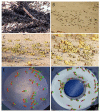Locust Collective Motion and Its Modeling
- PMID: 26656851
- PMCID: PMC4675544
- DOI: 10.1371/journal.pcbi.1004522
Locust Collective Motion and Its Modeling
Abstract
Over the past decade, technological advances in experimental and animal tracking techniques have motivated a renewed theoretical interest in animal collective motion and, in particular, locust swarming. This review offers a comprehensive biological background followed by comparative analysis of recent models of locust collective motion, in particular locust marching, their settings, and underlying assumptions. We describe a wide range of recent modeling and simulation approaches, from discrete agent-based models of self-propelled particles to continuous models of integro-differential equations, aimed at describing and analyzing the fascinating phenomenon of locust collective motion. These modeling efforts have a dual role: The first views locusts as a quintessential example of animal collective motion. As such, they aim at abstraction and coarse-graining, often utilizing the tools of statistical physics. The second, which originates from a more biological perspective, views locust swarming as a scientific problem of its own exceptional merit. The main goal should, thus, be the analysis and prediction of natural swarm dynamics. We discuss the properties of swarm dynamics using the tools of statistical physics, as well as the implications for laboratory experiments and natural swarms. Finally, we stress the importance of a combined-interdisciplinary, biological-theoretical effort in successfully confronting the challenges that locusts pose at both the theoretical and practical levels.
Conflict of interest statement
The authors have declared that no competing interests exist.
Figures



References
-
- Bullen FT (1966) Locusts and grasshoppers as pests of crops and pasture-a preliminary economic approach. Journal of Applied Ecology, 3: 147–168.
-
- Lomer CJ, Bateman RP, Johnson DL. Langewald J, Thomas M (2001) Biological control of locusts and grasshoppers. Annual review of entomology, 46(1): 667–702. - PubMed
-
- Uvarov B (1928) Locusts and grasshoppers. A handbook for their study and control Imperial Bureau of Entomology, London.
-
- Foster ZJ (2014). The 1915 Locust Attack in Syria and Palestine and its Role in the Famine During the First World War. Middle Eastern Studies, 51:3, 370–394.
-
- The Food and Agriculture Organization of the United Nations (2004) Hunger in their wake: inside the battle against the desert locust. http://www.fao.org/Newsroom/en/focus/2004/51040/index.html. Accessed May 2015.
Publication types
MeSH terms
LinkOut - more resources
Full Text Sources
Other Literature Sources
Research Materials
Miscellaneous

